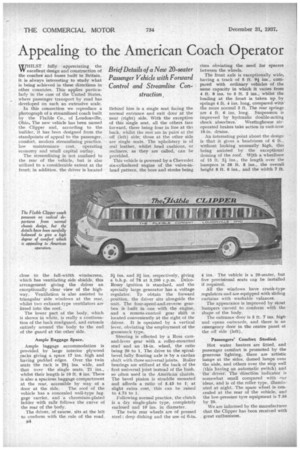Appealing to the American Coach Operator
Page 16

If you've noticed an error in this article please click here to report it so we can fix it.
Brief Details of a New 20-seater Passenger Vehicle with Forward Control and Streamline Construction ,
[WHILST fully appreciating the W excellent design and construction of the coaches and buses built in Britain, it is always interesting to study what is being achieved in these directions in other countries. This applies particulady in the case of the United States, where passenger transport by road has developed on such an extensive scale.
In this connection we reproduce a photograph of a streamlined coach built by the Flxible Co., of Loudonville, Ohio. The new vehicle has been named the •Clipper and, according to the builder, it has been designed from the standpoints of appeal to the passenger, comfort, modern streamlining practice. low maintenance cost, operating economy and small capital outlay.
The streamlining is not confined to the rear of the vehicle, but is also utilized to a considerable extent at the front; in addition, the driver is located close to the full-width windscreen, which has ventilating side shields, this arrangement giving the driver an exceptionally clear view of the highway. Ventilation is also assisted by triangular side windows at the rear. whilst two exhaust-type ventilators are fitted into the roof.
The lower part of the body, which is shown in white, is really a continuation of the back mudguard, and extends entirely around the body to the end of the guard at the other side.
Ample Baggage Space.
Ample luggage accommodation is provided by large interior plywood sacks giving a space 17 ins, high and having padded edges. Over the twin seats the tack is 29i ins, wide, and that over the single seats, 21 ins., whilst their length is 10 ft. 8 ins. There is also a spacious baggage compartment at the rear, accessible by way of a
door at the side. The roof of the vehicle has a concealed well-type luggage 'carrier, and a chromium-plated ladder with rails follows the curve of the rear of the body.
The driver, of course, sits at the left to conform with the rule of the road. 54 Behind him is a single seat facing the normal entrance and exit door at the near (right) side. With the exception of this single seat, all the others face forward, there being four in line at ths, back, whilst the rest are in pairs at the off (left) side; those at the other side are single seats. The upholstery is of real leather, whilst head cushions, or recliners, as they are called, can be provided.
This vehicle is powered by a Chevrolet. six-cylindered engine of the valve-inhead pattern, the bore and stroke being
3,i ins. and 32. ins, respectively, giving a b.h.p. of 78 at 3,200 r.p.m. DelcoRemy ignition is standard, and the specially large generator has a voltage regulator. To obtain the forward position, the driver sits alongside the unit. The four-speed-and-reverse gearbox is built in one with the engine, and a remote-control gear shift is located conveniently at the right of the driver. It is operated by a vertical lever, obviating the employment of the gooseneck type.
Steering is effected by a Ross camand-lever gear with a roller-mounted stud and an 18-in, wheel, the ratio being 20 to 1. The drive to the spiralbevel fully floating axle is by a =dam shaft with three universal joints. Roller bearings are utilized at the back of the first universal joint instead of the bush. so often used in the American chasSis. The bevel pinion is straddle mounted and affords a ratio of 5.43 to 1; at slight extra cost, this can he raised to 4.75 to 1.
Following normal practice, the clutch is a dry single-plate type, completely enclosed and 10 ins, in diameter.
The twin rear wheels are of pressed steel ; deep dishing and the use of 6-in. rims obviating the need for spacers between the wheels.
The front axle is exceptionally wide, having a track of 5 ft. sir ins., cornpared with ordinary vehicles of the same capacity in which it varies from 4 ft. 8 ins, to 5 ft. 2 ins., whilst the loading at the front is taken up by springs 4 ft. 4 ins, long, compared with the more normal 3 ft. The rear springs are 4 ft. 6 ins. long. Suspension is improved by hydraulic double-acting
shock absorbers. Westinghouse air operated brakes take action in cast-iron 16-in. drums.
An interesting point about the design is that it gives a headroom of 6 ft., without looking unusually high, this being assisted by the exceptional doming of the roof. With a wheelbase of 15 ft. 2i ins., the length over the bumpers is 26 ft. 8 ins., the overall height 8 ft. 6 ins., and the width 7 ft.
4 ins. The vehicle is a 20-seater, but five provisional seats can be installed if required.
All the windows have crank-type regulators and are equipped with sliding curtains with washable valances.
The appearance is improved by stout bumpers curved to conform with the shape of the body.
The entrance door is 5 ft. 7 ins, high and opens outwards, and there is an emergency door in the centre panel of the off side (left).
Passengers' Comfort Studied.
Hot water heaters are fitted, and passenger comfort is promoted by the generous lighting, there are artistic lamps at the sides, domed lamps °vet the aisle, and others over the step well (this having an automatic switch) and the driver. The direction indicator is somewhat small compared with our ideas, and is of the roller type, illuminated at night. The spare wheel is concealed at the rear of the vehicle, and the low-pressure tyre equipment is 7.50 by 20.
We are informed by the manufacturer that the Clipper has been received with great enthusiasm.
































